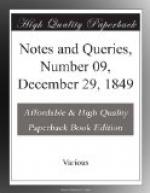“Call up the butler of this house,
Put on his golden ring,
Let him bring us up a glass of beer,
And the better we shall
sing.
“We have got a little purse,
Made of stretching leather
skin,
We want a little of your money,
To line it well within.
“Bring us out a table,
And spread it with a
cloth,
Bring us out a mouldy cheese,
And some of your Christmas
loaf.
“God bless the master of this house,
Likewise the mistress
too,
And all the little children,
That round the table
go.
“Good master and mistress,
While you’r sitting by the fire,
Pray think of us poor children,
Who are wand’ring in the mire.
“Cho.—Love
and joy come to you,
And to your wessel to,
And God send you a happy new year,
A new year,
And God send you a happy new year.
Our wessel cup is made of the rosemary
tree,
So is your beer of the best barley.”
It is a song of the season which well deserves to be preserved. Its insertion will at least have that effect, and may be the means of our discovering an earlier and purer text.
AMBROSE MERTON.
Portrait of Charles I.—In Sir Henry Ellis’s Original Letters, 2d series, vol. iii. p. 254., amongst the prefatory matter to the reign of Charles I., there is a notice of a sermon, entitled “The Subject’s Sorrow, or Lamentations upon the Death of Britaine’s Josiah, King Charles.”
Sir Henry Ellis says it is expressly stated, in this Sermon, that the King himself desired “that unto his Golden Manual might be prefixed his representation, kneeling; contemning a temporal crown, holding our blessed Saviour’s crown of thorns, and aspiring unto an eternal crown of happiness.”
Note b. upon this passage is as follows:—
“This very portrait of King Charles the First, engraved by Marshall, adorned the original edition of the [Greek: Eikon Basilikae]. 8vo. 1648. The same portrait, as large as life, in oil painting, was afterwards put up in many of our churches.”
When I was a boy, such a portrait, in oil painting, hung upon the south wall of the body of St. Michael’s Church, Cambridge, between the pulpit and a small door to the west, leading into the south aisle.
Out of the window of the chamber in which the King was kneeling was represented a storm at sea, and the ship being driven by it upon some rocks.
A few years ago, upon visiting Cambridge, I went purposely to St. Michael’s Church to see this picture, which had been so familiar to me in my boyhood. The clerk told me it had been taken down, and was in the vestry. In the vestry I found it, on its side, on the floor against the wall. {138}
You are probably aware that this St. Michael’s Church was nearly destroyed by fire not many weeks since; that a committee is established to arrange its restoration.




